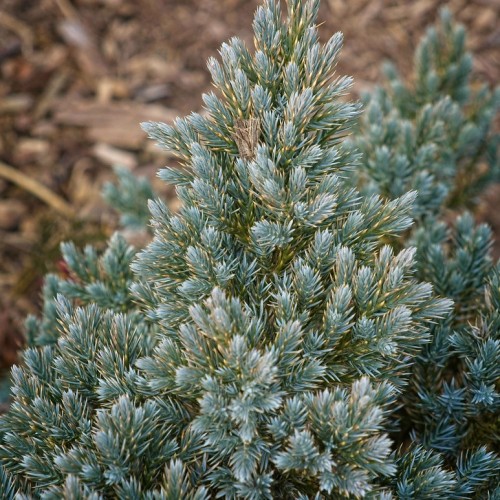
juniper
Juniperus pfitzeriana 'Armstrongii'
Cycle:
Perennial
Watering:
Average
Hardiness Zone:
3 - 9
Flowers:
Flowers
Sun:
Full sun
Cones:
Yes
Leaf:
Yes
Growth Rate:
Low
Maintenance:
Low
Drought Tolerant:
Yes
Salt Tolerant:
Yes
Care Level:
Medium
watering
Junipers need to be well-watered to stay healthy and vibrant, but they are also quite drought tolerant, which makes them an ideal choice for gardeners who can't water frequently. In general, junipers should be watered about once every week or 2, although this depends on the time of year and the kind of soil they're in. Junipers in heavy clay soils may need to be watered more often, whereas those in light, sandy soils can go a few weeks between waterings. During the spring and summer, junipers should be checked periodically. Water only when the top couple of inches of soil are dry. In winter, junipers should be watered once every 4 to 6 weeks. Make sure to saturate the entire root zone before moving on to the next plant.
sunlight
Juniperus pfitzeriana 'Armstrongii' thrives in full sun, meaning it needs at least 6 to 8 hours of direct sunlight each day. During the spring and summer seasons, the juniper should receive full sun the entire day in order for it to remain healthy. During the fall and winter, the hours of direct sunlight should be decreased to 4 to 5 hours a day.
pruning
Juniperus pfitzeriana 'Armstrongii' should be pruned annually in late winter or early spring. Pruning should only be done to remove dead, dying, and diseased branches, and to promote a desirable shape. Extend the seasons between heavy pruning sessions by only removing branch tips annually. Trimming the longest branches back by at least half will encourage new growth and shape. Maintain a moderate to dense shrub by removing 1/3 of the oldest branches at the base of the plant.
Season
Hardiness Map
FAQ
Is Juniper Bonsai suitable for indoor cultivation?
Yes, Juniper Bonsai is suitable for indoor cultivation. As an evergreen conifer, Juniper Bonsai is accustomed to low light, making it a great choice for indoors. Juniper Bonsai tend to thrive in cooler temperatures, so keeping it near a drafty window or in a porch area can provide the ideal environment. Its small size also makes it a suitable choice for limited space. Juniper Bonsai require weekly or bi-weekly watering to stay healthy, and the soil should be allowed to dry out completely between waterings.
Should I repot my Juniper Bonsai annually??
Yes, you should repot your Juniper Bonsai annually. Repotting is a necessary part of Juniper Bonsai care, because it allows for newly established roots to spread out and helps the tree to access more nutrients. The roots should be disturbed annually, as Juniper Bonsais tend to become potbound quickly. Choose a pot with drainage holes that is slightly larger than the previous pot, and use a well-drained soil mix specifically designed for Bonsais. Use the same procedure during repotting as when the Juniper was first potted, including pruning any roots that are coiled or tangled around the edges of the pot.
Do Juniper Bonsai plants require a dormant period?
Yes, Juniper Bonsai plants do require a dormant period. Dormant period for Juniper Bonsai plants typically lasts for 2-3 months, from late autumn to early spring. During that time, the temperature should not go below 5°C (41°F) and the soil should be kept fairly dry. The bonsai will not require any watering during this period, and should be kept in an environment that is cool and dark. This will allow the Juniper Bonsai to rest and prepare for the upcoming growing season.
Are there any special techniques for shaping Juniper Bonsai?
Yes, there are a few special techniques used for shaping Juniper Bonsai. These techniques include pruning, wiring, and defoliation. Pruning, or cutting away unwanted branches, is done to keep the bonsai's shape as it grows. Wiring is used to give the bonsai its desired shape, and defoliation can be used to reduce leaf size and produce better ramification. By using these techniques, the bonsai can be shaped and developed over time.
Juniper Bonsai be grown in a group planting style?
A group planting style is a common way to display and grow juniper bonsais. This style of planting translates to multiple bonsais planted together in a container, where each tree has its own space and is carefully positioned in relation to the other trees. This type of planting provides the bonsai artist with a stunning display of multiple bonsai plants and allows for a great opportunity to show off a collection of bonsais at once.
Is Juniper Bonsai suitable for outdoor gardens?
Yes, Juniper Bonsai is suited to outdoor gardens if certain conditions are met. They prefer to be placed in areas with good air circulation, preferably not in windy spots, and they require several hours of direct sunlight each day. The soil should be well-draining, and the tree should be watered frequently during hot weather. Juniper Bonsai should be protected from extreme temperatures, either through shelter or containers. Gardeners should also protect the tree from potential wind damage, either by covering it in extreme conditions or by placing it away from winds.
Is Juniper Bonsai considered a long-lived plant?
Yes, Juniper Bonsai is considered a long-lived plant. It is a strong plant that lives for decades and even centuries with proper care and maintenance. These little trees require regular pruning, proper watering, and care to stay healthy and can live up to 200 years old. Bonsai trees that are properly cared for are often passed down through generations and cherished by families for many years.
